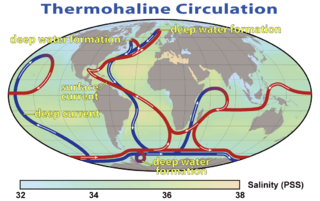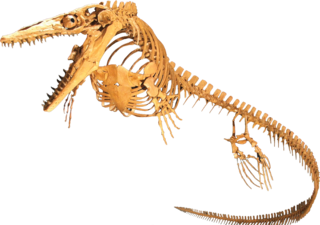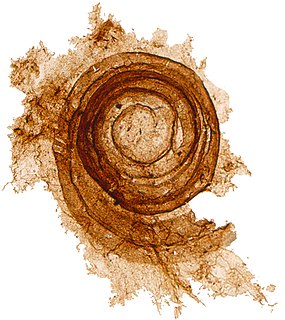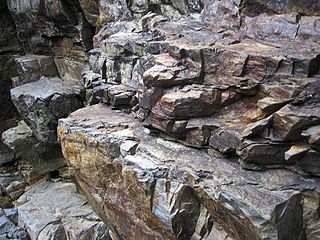The Triassic is a geologic period and system which spans 50.6 million years from the end of the Permian Period 251.902 million years ago (Mya), to the beginning of the Jurassic Period 201.36 Mya. The Triassic is the first and shortest period of the Mesozoic Era. Both the start and end of the period are marked by major extinction events. The Triassic Period is subdivided into three epochs: Early Triassic, Middle Triassic and Late Triassic.

Oceanography, also known as oceanology, is the scientific study of the oceans. It is an important Earth science, which covers a wide range of topics, including ecosystem dynamics; ocean currents, waves, and geophysical fluid dynamics; plate tectonics and the geology of the sea floor; and fluxes of various chemical substances and physical properties within the ocean and across its boundaries. These diverse topics reflect multiple disciplines that oceanographers utilize to glean further knowledge of the world ocean, including astronomy, biology, chemistry, climatology, geography, geology, hydrology, meteorology and physics. Paleoceanography studies the history of the oceans in the geologic past. An oceanographer is a person who studies many matters concerned with oceans including marine geology, physics, chemistry and biology.

Sediment is a naturally occurring material that is broken down by processes of weathering and erosion, and is subsequently transported by the action of wind, water, or ice or by the force of gravity acting on the particles. For example, sand and silt can be carried in suspension in river water and on reaching the sea bed deposited by sedimentation; if buried, they may eventually become sandstone and siltstone through lithification.

The Ross Sea is a deep bay of the Southern Ocean in Antarctica, between Victoria Land and Marie Byrd Land and within the Ross Embayment, and is the southernmost sea on Earth. It derives its name from the British explorer James Ross who visited this area in 1841. To the west of the sea lies Ross Island and Victoria Land, to the east Roosevelt Island and Edward VII Peninsula in Marie Byrd Land, while the southernmost part is covered by the Ross Ice Shelf, and is about 200 miles (320 km) from the South Pole. Its boundaries and area have been defined by the New Zealand National Institute of Water and Atmospheric Research as having an area of 637,000 square kilometres (246,000 sq mi).

Palynology is literally the "study of dust" or of "particles that are strewn". A classic palynologist analyses particulate samples collected from the air, from water, or from deposits including sediments of any age. The condition and identification of those particles, organic and inorganic, give the palynologist clues to the life, environment, and energetic conditions that produced them.

The Geological Society of London, known commonly as the Geological Society, is a learned society based in the United Kingdom. It is the oldest national geological society in the world and the largest in Europe with more than 12,000 Fellows.

A raised beach, coastal terrace, or perched coastline is a relatively flat, horizontal or gently inclined surface of marine origin, mostly an old abrasion platform which has been lifted out of the sphere of wave activity. Thus, it lies above or under the current sea level, depending on the time of its formation. It is bounded by a steeper ascending slope on the landward side and a steeper descending slope on the seaward side. Due to its generally flat shape it is often used for anthropogenic structures such as settlements and infrastructure.

Paleoecology is the study of interactions between organisms and/or interactions between organisms and their environments across geologic timescales. As a discipline, paleoecology interacts with, depends on and informs a variety of fields including paleontology, ecology, climatology and biology.

In geology, a rift is a linear zone where the lithosphere is being pulled apart and is an example of extensional tectonics.

The Last Glacial Period (LGP), also known colloquially as the last ice age or simply ice age, occurred from the end of the Eemian to the end of the Younger Dryas, encompassing the period c. 115,000 – c. 11,700 years ago. The LGP is part of a larger sequence of glacial and interglacial periods known as the Quaternary glaciation which started around 2,588,000 years ago and is ongoing. The definition of the Quaternary as beginning 2.58 million years ago (Mya) is based on the formation of the Arctic ice cap. The Antarctic ice sheet began to form earlier, at about 34 Mya, in the mid-Cenozoic. The term Late Cenozoic Ice Age is used to include this early phase.

Mosasaurs comprise a group of extinct, large marine reptiles from the Late Cretaceous. Their first fossil remains were discovered in a limestone quarry at Maastricht on the Meuse in 1764. They belong to the order Squamata, which includes lizards and snakes.

A microfossil is a fossil that is generally between 0.001 mm and 1 mm in size, the visual study of which requires the use of light or electron microscopy. A fossil which can be studied with the naked eye or low-powered magnification, such as a hand lens, is referred to as a macrofossil.

Marine geology or geological oceanography is the study of the history and structure of the ocean floor. It involves geophysical, geochemical, sedimentological and paleontological investigations of the ocean floor and coastal zone. Marine geology has strong ties to geophysics and to physical oceanography.

Maria Vasilyevna Klenova was a Russian and Soviet marine geologist and one of the founders of Russian marine science and contributor to the first Soviet Antarctic atlas.
The GeoRef database is a bibliographic database that indexes scientific literature in the geosciences, including geology. Coverage ranges from 1666 to the present for North American literature, and 1933 to the present for the rest of the world. It currently contains more than 2.8 million references. It is widely considered one of the preeminent literature databases for those studying the earth sciences.

Earth science or geoscience includes all fields of natural science related to the planet Earth. This is a branch of science dealing with the physical, chemical, and biological complex constitutions and synergistic linkages of Earth's four spheres, namely biosphere, hydrosphere, atmosphere, and geosphere. Earth science can be considered to be a branch of planetary science, but with a much older history. Earth science encompasses four main branches of study, the lithosphere, the hydrosphere, the atmosphere, and the biosphere, each of which is further broken down into more specialized fields.
In sedimentary geology and geomorphology, the term progradation refers to the growth of a river delta farther out into the sea over time. This occurs when the volume of incoming sediment is greater than the volume of the delta that is lost through subsidence, sea-level rise, or erosion.

A geologist is a scientist who studies the solid, liquid, and gaseous matter that constitutes Earth and other terrestrial planets, as well as the processes that shape them. Geologists usually study geology, although backgrounds in physics, chemistry, biology, and other sciences are also useful. Field research is an important component of geology, although many subdisciplines incorporate laboratory and digitalised work.
Chronological dating, or simply dating, is the process of attributing to an object or event a date in the past, allowing such object or event to be located in a previously established chronology. This usually requires what is commonly known as a "dating method". Several dating methods exist, depending on different criteria and techniques, and some very well known examples of disciplines using such techniques are, for example, history, archaeology, geology, paleontology, astronomy and even forensic science, since in the latter it is sometimes necessary to investigate the moment in the past during which the death of a cadaver occurred. These methods are typically identified as absolute, which involves a specified date or date range, or relative, which refers to dating which places artifacts or events on a timeline relative to other events and/or artifacts. Other markers can help place an artifact or event in a chronology, such as nearby writings and stratigraphic markers.
Hassan Nasiem Siddique (1934–1986) was an Indian marine geologist and the director of the National Institute of Oceanography. He was the deputy leader of the first Indian expedition to the Antarctica during 1981–82. He was known for his geological studies on Bay of Bengal and the Arabian Sea and was an elected fellow of the Indian National Science Academy, Geological Society of India, Association of Exploration Geophysicists and the National Academy of Sciences, India. The Council of Scientific and Industrial Research, the apex agency of the Government of India for scientific research, awarded him the Shanti Swarup Bhatnagar Prize for Science and Technology, one of the highest Indian science awards for his contributions to Earth, Atmosphere, Ocean and Planetary Sciences in 1978. The Government of India awarded him the fourth highest Indian civilian honour of Padma Shri in 1983.














